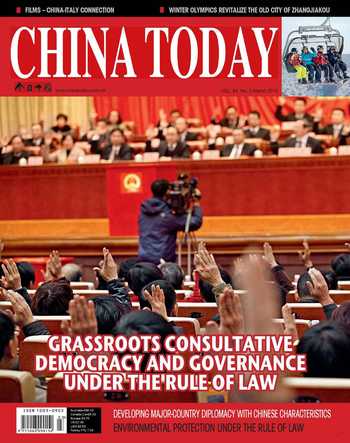Ties That Bind
By JIANG YUECHUN
SINCE Japans “nationalization” of the Di- aoyu Islands, Sino-Japanese relations have come to a deadlock. Under this frigid political backdrop, bilateral trading ties and how they should be handled now merit deep consideration.
Common Interests
Since China and Japan established diplomatic relations, the two countries economic and trade relations have made remarkable achievements. In 1972 the trade volume between China and Japan was only US $1 billion. This figure skyrocketed to US $344.9 billion in 2011, increasing exponentially within four decades. However, due to worsening bilateral relations in 2012 and 2013, Sino-Japanese trade declined 3.9 percent and 5.1 percent respectively year-on-year.
Japan is a key source of Chinas foreign investment. By the end of 2011, Japan had invested in more than 40,000 projects in China, amounting to a total of US $81.23 billion. More importantly, the investment structure shifted from labor-intensive to technology- and capital-intensive, with investment fields extending from clothing and foodstuffs to electronics, machinery, automobiles, building materials, and services. But since 2012, Japans investment in China has dropped dramatically. During the first three quarters of 2014, Japan invested US $3.39 billion in China, a year-on-year decline of 43 percent that was beyond all expectations.
For a long time, Sino-Japanese financial cooperation has had Official Development Assistance (ODA) at its core. In recent years, the two countries have strengthened their cooperation in the financial field; for instance, their central banks have established a regular dialogue mechanism, and set up more branches in each others countries. In March 2002, the two governments signed a currency swap agreement, realizing high-level financial cooperation in the Asia-Pacific region. In 2012, Japan purchased US $10 billion of Chinas government bonds. On June 1, 2012, China and Japan achieved direct trading of RMB and yen, a significant step in the development of bilateral relations.
Deepened Economic and Trade Exchanges Needed
Starting from its reform and opening-up in 1978, Chinas economy entered the “fast lane.”From 1978 to 2011, Chinas annual average economic growth was consistently above nine percent (on the basis of comparable prices in 2000). Entering the 21st century, Chinas GDP world ranking surpassed that of many developed economies. In 2007, China overtook Germany to become the worlds third largest economy. In the wake of the global financial crisis in 2008, China realized an economic recovery faster than that of any developed country. In 2010, its GDP overtook Japans, elevating China to the second largest economy after the U.S.
However, this does not mean that Chinas comprehensive national strength was any greater than Japans. In fact, there are still disparities between China and Japan in many aspects. In the age of economic globalization, GNP is a more accurate measure of a countrys economic aggregate than GDP. Besides, in terms of GDP per capita, the two countries differ greatly. Based on IMF statistics of April 8, 2014, the GDP per capita of Chinas mainland in 2013 was US $6,747 and that of Japan was US $38,491, giving them respective world rankings of 81st and 24th. A nations comprehensive power can be evaluated by many other indexes, such as scientific and technological strength, the amount of energy consumed per unit of GDP, and scientific research input. Judging from these aspects, the gaps between the two countries are obvious.
Yet the Chinese market is important to Japan. In terms of trade in goods, according to statistics from China Customs, in 2011, 23.7 percent of Japans gross export was shipped to China, and 17.4 percent of Japans gross import came from China. Judging from this development trend, it is deemed profitable to invest in China. At present, Japanese enterprises in China are in a period of transition, with investment activities gradually shifting from the manufacturing industry to the production of consumer goods and service industries. Chinese consumers are spending more, and Japan wants to sell its goods and services to them. Therefore, the powerful Chinese market offers Japanese enterprises the lions share, contributing to Japans sustainable economic development. As China enters a period of economic adjustment, its labor costs keep rising. However, Chinas severely unbalanced economic development and internal disparities will bring about more business opportunities for Japanese-funded enterprises.
Chinas Advantage
Any regional or national economic development has its own lifecycle. If we think of the 1960s as the adolescence of the Japanese economy, then its bubble economy at the end of 1980s was its prime, and it has entered into a persistently depressed senescence since the early 1990s. Chinas GDP per capita exceeded US $5,000 in 2011. If we ignore price factors, this level is roughly equal to Japans figures in the early 1970s. This shows that China has huge space and potential for economic expansion.
Moreover, Chinas urbanization will create unparalleled room for economic development. It is generally acknowledged that the process of urbanization consists of a preparatory phase (when the urbanization rate is below 10 percent), an initial phase (below 30 percent), a boom phase (below 70 percent) and a stable phase (above 70 percent). The urbanization levels in the U.S., Japan and France have been in the stable phase since the 1960s. Of the worlds top 10 economies, only China and India are failing in urbanization. According to the World Banks 2011 forecast, it will take China at least 24 years to reach the stable phase of urbanization. In other words, before 2035, urbanization will continuously provide the country with development momentum, a unique advantage over any developed country.
Significant development in Sino-Japanese economic relations not only serves the common interests of both countries and peoples, but also makes a great contribution to the peace and prosperity of Asia and the world.

